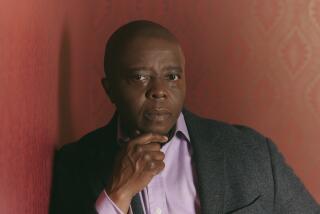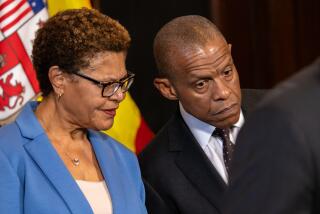Words and Pictures: ‘To Protect & Serve?’ showcases 50 years of police brutality protest posters
- Share via
Trayvon Martin. Michael Brown. Sandra Bland. Eric Garner. Freddie Gray.
In recent years, police brutality has been at the heart of several high-profile cases both in the news and on social media. The Black Lives Matter and Hands Up United movements began in direct response to it. It made an unlikely icon out of Colin Kaepernick and inspired other athletes to take a knee during the national anthem.
It led to protests across the country and sparked a national conversation. Now, the subject is being explored in the Center for the Study of Political Graphics’ exhibition “To Protect & Serve? Five Decades of Posters Protesting Police Violence.”
Held (fittingly) in a former police station, the exhibit (which runs through Mar. 31 at Venice’s Durón Gallery) features 75 international and domestic protest posters. In May, it will move to Mercado la Paloma in downtown Los Angeles.
“A lot of these posters go back to the ’60s and ’70s,” said curator Carol Wells. (However, the oldest one on display is a reproduction of an abolitionist poster dating back to 1851.)
The posters are organized into nine chapters: “Policing as Political Repression,” “Gender Profiling & Sexual Violence,” “Civil Rights, Government Wrongs,” “Immigration,” “Racial Profiling & the School to Prison Pipeline,” “Militarization of Law Enforcement,” “International,” “Murdered by the State” and “Organizing Resistance.” There’s also a wall where visitors are invited to share their comments and personal stories. (“Such an important exhibition!” read one note. “Police need to be held accountable!”)
“Any one of these subjects could have an entire exhibit about it, so we really had to be selective,” said Wells.
She stops in front of one of the posters, titled “Wanted for Murder,” part of the Police Corruption chapter.
“This one is fascinating because this talks about how there was an intentional recruitment of white supremacists and Klan members into the LAPD and other law enforcement agencies,” Wells said. “[Chief William] Parker literally recruited people from the South. So it is systemic. A lot of people say, ‘It’s just a few bad cops, they get all the attention,’ and one of the things we’re trying to show with this exhibition is that’s too dismissive of the nature of the problem.”
Funded by the Mike Kelley Foundation of the Arts, the exhibit almost didn’t happen because of the controversial subject matter.
“Nobody would fund it and nobody would host it because everybody was afraid,” Wells said. “And then the Mike Kelley Foundation asked me to pick a subject that nobody else would fund. Because that was the kind of thing he did. He was always pushing limits.”
Here, Wells explains a few of the CSPG posters in her own words, along with background information from the gallery guide.
POLICING AS POLITICAL REPRESSION
2. Caution!!
Law enforcement in the United States emerged from colonial systems of enforcing slavery. A watch-system of citizen volunteers (predominantly men) conducted “slave patrols,” which regulated the movements of enslaved and free black people, guarded against slave rebellions and exercised physical brutality to enforce the slave codes. Slave patrols were the first publicly funded police agencies in the U.S. after the Revolution. They remained in place during the Civil War and continued after the 13th Amendment outlawed slavery.
One of the oldest posters in the exhibit, “Caution!!” is a reproduction of an 1851 poster put out by the abolitionist movement in Boston warning black people — both runaway slaves and freed men — that police would kidnap them and take them down South into slavery.
“This set the stage for how policing as we know it was really set into play after the abolition of slavery, after the Civil War, as a way of continuing slavery but under now-legal means,” said Wells. “It was really important [to us] to give a historical perspective [to show that] policing as we know it has a long history of repression.”
5. L.A. SWAT Squad Logo
“Daryl Gates started the first SWAT Squad, and it was specifically to target the Black Panther Party,” said Wells. “Someone told me years ago that they had an insignia that referenced the first two major events or attacks. One was against the Black Panther Party and one was against the SLA where they burned that house down. In doing research for this exhibition, we had a community curatorial committee, activists and attorneys who’d been working on police abuse for many years. One of the members went online and she found the badge. That they’re bragging about these two events is kind of mind-boggling.”
The research team found that the numbers 41 and 54 on the SWAT Squad logo reference addresses in South Central Los Angeles where two major SWAT squad actions took place: 41st and Central was the address of the Black Panther Party offices, attacked by the SWAT squad in its 1969 debut. Researchers also found that on May 17, 1974, the SWAT squad and FBI attacked a house on East 54th Street where members of the Symbionese Liberation Army (SLA) — responsible for kidnapping newspaper heiress Patty Hearst — were hiding.
MILITARIZATION OF LAW ENFORCEMENT
30. L.A. ’84...Official Olympics Police State
This poster directs attention to the intensified militarization of the LAPD and the coordination of many branches of law enforcement, both local and federal, that took place prior to the 1984 Olympics. This was allegedly in response to later discredited reports that Los Angeles faced a threat of terrorist action during the Games. But the primary reason was to suppress potential domestic unrest during the Olympics.
“This one is very timely because we’re talking about the L.A. Olympics coming up,” said Wells, referring to the 2028 Games here. “But that was one of the major opportunities to militarize the police and to target the black and brown communities. And the next Olympics promises to militarize even more.”
“To Protect & Serve? Five Decades of Posters Protesting Police Violence” is on display at Durón Gallery at SPARC, 685 Venice Blvd., through Feb. 28 from 11 a.m. to 5 p.m. Tuesdays through Saturdays. Admission to the gallery is free. For more information, visit sparcinla.org.
follow me on twitter @sonaiyak
More to Read
Only good movies
Get the Indie Focus newsletter, Mark Olsen's weekly guide to the world of cinema.
You may occasionally receive promotional content from the Los Angeles Times.











